Projects
Embry-Riddle has been awarded grants to support research on three ASSURE projects alongside our ASSURE partners. Additional project proposals are under the FAA’s review. Opportunities exist for industry sponsorships through monetary and in-kind contributions.
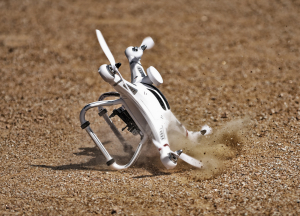
A4: UAS Ground Collision Severity Evaluation
Biomechanical engineering researchers will evaluate the hazards and risks associated with UAS operations in the National Airspace System as it relates to humans on the ground. This research will estimate the level of human injury that would be associated with a human being struck by a UAS by evaluating the size, shape, impact and materials of the aircraft and their impact. Researchers will use advanced computational modeling techniques to simulate UAS impact on humans. The results will be used to suggest ways to improve the safety of UAS operations.
Principal Investigator: Feng Zhu, Assistant Professor of Mechanical Engineering

A5: UAS Maintenance, Modification, Repair, Inspection, Training and Certification Considerations
This study will determine the maintenance and inspection requirements for unmanned aircraft systems. From the proposed requirements, a curriculum to train aviation technicians on the repair and maintenance of unmanned aircraft will be developed.
Principal Investigator: John Robbins, College of Aviation
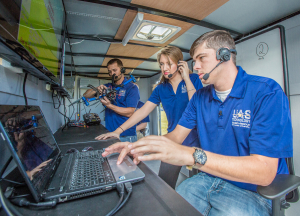
A6: Surveillance Criticality for SAA
Researchers will assess the required technology and operational safety to integrate UAS into the National Airspace System. This research will help determine the efficiency of existing airborne surveillance equipment such as radar, transponders, etc., typically used on manned aircraft, as well as novel sense-and-avoid (SAS) technologies. Modeling and simulation work at the Next-Generation ERAU Applied Research (NEAR) Lab will assess these technologies under simulated scenarios.
Principal Investigator: Mohammad Moallemi, Research Associate, NEAR Lab
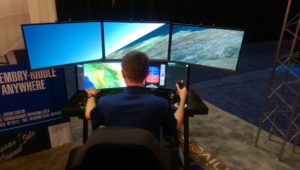
A10: Human Factors Considerations of UAS Procedures, & Control Stations
This project is a cross-institution collaboration focusing on analyzing and recommending improvements to unmanned systems’ work station designs, environments, and ergonomics; UAS pilot and crew member procedures; and operational requirements for various size classes of UAS. The project draws on subject matter experts from the ASSURE Centers of Excellence at Embry-Riddle Aeronautical University, Drexel University, Kansas State University, Mississippi State University, the Ohio State University, University of North Dakota, and Sinclair Community College.
Principal Investigator: Richard Stansbury, ERAU Site Director, ASSURE FAA Center of Excellence for UAS

A16 – Airborne Collision Severity Evaluation – Structural Impact
This study investigated through modeling and simulation the trajectory of a UAS as it approaches a NASA Common Research Model (CRM) aircraft. This study considered several different scenarios with different locations of the CRM aircraft and conditions to determine the degree of deflection of the UAS through the encounter. Results showed that the displacement was not sufficient in any of the impact scenarios to prevent collision between the DJI drone model and the CRM.
Principal Investigator: Fardin Khalili, Ph.D.
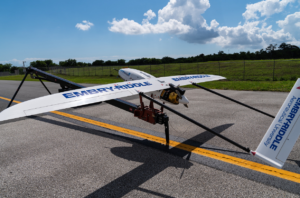
A20: UAS Parameters, Exceedances, Recording Rates for ASIAS
The purpose of this research is to enable safe integration of Unmanned Aircraft Systems (UAS) in the NAS through building upon existing aviation database and data-sharing efforts encouraged and endorsed by participating government-industry entities. Through this research, a data architecture for unmanned air and ground vehicles and operations will be developed in alignment with the FAA’s Aviation Safety Information and Sharing (ASIAS) program. In addition, this project will identify current UAS FDM capabilities and practices, including refresh/recording rate and robustness, and develop guidance for a UAS FDM standard. Equally will identify UAS FDM events, including event definitions and exceedances, using the normal ASIAS techniques.
Principal Investigator: Dave Esser, Ph.D.
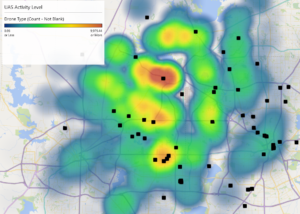
A21 – Integrating Expanded and Non-Segregated UAS Operations into the NAS: Impact on Traffic
For the ASSURE A21 project, the Embry-Riddle team explored numerous data sets that the FAA has been collecting on UAS activities including remote pilot certificate data (de-identified), aircraft registrations, UAS sighting reports, Part 107 waivers, incident/accident preliminary reports, etc. The team helped develop a data catalog, explored current data practices, and analyzed the data to determine trends and insights correlated to the introduction of new small UAS rules and policy changes. Additionally, ERAU analyzed ADS-B data compared with UAS detection data to correlate the proximity at which UAS flew near aircraft in the vicinity of airports.
Principal Investigator: Richard Stansbury, Ph.D.
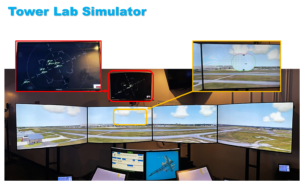
A36 – Urban Air Mobility Study: Safety Standards, Aircraft Certification, and Impact on Market Feasibility and Growth Potentials
ERAU led working package #3 of the A36 project, which sought to identify the impact of UAM on the National Airspace System with respect to air traffic control, infrastructure, and operations. In this report, the team provides recommendations toward future technological developments, approaches to UAM airspace integration, infrastructure enhancements, and new regulations, policies, and procedures to support UAM flights in the NAS. A literature review addressed these topics. Based on the literature review, the team proposes an airspace concept to support UAM operations in the vicinity of Daytona Beach International Airport. The team constructed a simulation of the airspace concept with scenarios involving traditional crewed aircraft and UAM, which was used to evaluate the impact of UAM on ATC workload and performance. The results of those experiments show in the local control position there is a greater workload with UAM vs. without, and ATC performance went down when UAM are present for both local control and ground control positions.
Principal Investigator: Richard Stansbury, Ph.D.

A37 – UAS Standards Tracking, Mapping, and Analysis
Development of consensus standards that can be used as acceptable means of compliance is critical to the successful integration of uncrewed aircraft systems into the National Airspace. However, timely development of standards requires tracking existing and in-development standards and identifying gaps in research needed to develop future standards. This project sought to track existing and in-development standards, map them to the FAA’s UAS Integration Research Plan, and identify research gaps that must be filled for standards to be developed that support the UIRP capabilities. Two software applications were developed to track standards and research gaps. A total of 180 research gaps were identified and/or tracked. Information about standards and research gaps should be centralized and made available to stakeholders.
Principal Investigator: Richard Stansbury, Ph.D.
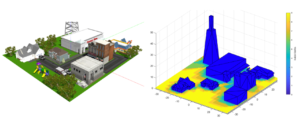
A44 – Mitigating GPS and ADS-B Risks for UAS
Unvalidated or unavailable GPS and “ADS-B In” data poses security and safety risks to automated UAS navigation and to Detect and Avoid operations. Erroneous, spoofed, jammed, or dropouts of GPS data may result in unmanned aircraft position and navigation being incorrect. This may result in a fly away beyond radio control, flight into infrastructure, or flight into controlled airspace. Erroneous, spoofed, jammed, or dropouts of “ADSB-In” data may result in automated unmanned aircraft being unable to detect and avoid other aircraft or result in detecting and avoiding illusionary aircraft. For automated Detect and Avoid, a false ADS-B track can potentially be used to corral the unmanned aircraft to fly towards controlled airspace, structures, terrain, and so on.
The project addresses the potential security and safety risks associated with reliance on GPS and ADS- B In data, low cost, and easy to implement solutions to mitigate GPS and ADS- B risks, and policy recommendations to FAA to better manage potential security and safety risks associated with reliance on GPS and ADS-B data. This research is necessary to enable safe and secure automated sUAS navigation and safe and secure automated sUAS Detect and Avoid operations.
Highlights
- Literature review of the risks associated with reliance on GPS and ADS- B In data.
- Development of a high-fidelity simulation environment to analyze the risks associated with reliance on GPS and ADS- B In data.
- A set of mitigation strategies have been proposed and are currently being tested in simulation for potential demonstration in flight testing.
Principal Investigator: Hever Moncayo, Ph.D.

A45 – Shielded UAS Operations – Detect and Avoid (DAA)
Shield UAS operations exist when a small UAS (sUAS) operates in close proximity to structures that are collision hazards for manned UAS such as buildings, vegetation, etc. under the assumption of lower risk because the sUAS is shielded from manned traffic. Industry and the FAA believe that some reduction in DAA requirements (to avoid other aircraft) when shielded by flight obstacles may be appropriate. Currently there is no comprehensive analysis to determine the correct balance between mitigating UAS hazards with other nearby low altitude manned aircraft and enabling shielded operations.
This project is intended to identify risks and recommend solutions to the FAA that enable shielded UAS operations. This project will identify risks, determine whether shielded operations can be made safe, to what degree UAS Detect and Avoid requirements can be reduced, and recommend UAS standoff distances from manned aviation flight obstacles.
Highlights
- Completed a risk assessment for the impact of shielding operations within different environments.
- Developed a simulation environment that includes different navigation threats such as multipath, obstruction of non-cooperative and cooperative obstacles.
Principal Investigator: Hever Moncayo, Ph.D.
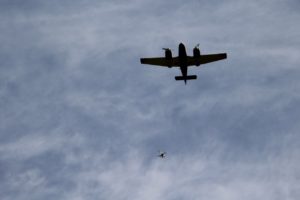
A47 – sUAS MAC Likelihood
Complete Mid-Air Collision (MAC) risk assessments require estimates of both collision severity and collision likelihood. This research focuses on sUAS MAC likelihood analysis with General Aviation (GA) and Commercial aircraft. Because severity research varies based on where a collision occurred on a manned aircraft, this likelihood research will not only look at the probability of MAC, but also the likelihood of colliding with different parts of a manned aircraft.
In order to complement other collision severity research and produce a complete risk assessment of sUAS Mid-Air Collision (MAC) with manned aircraft, MAC likelihood research is needed. Because collision severity depends on where the collision occurred on a manned aircraft, this likelihood research will not only investigate overall MAC probabilities but also the MAC probabilities with different parts of manned aircraft. This likelihood assessment will investigate sUAS collisions with both General Aviation and Commercial aircraft.
The following research questions will be answered:
- What is the probability of a UAS without a detect and avoid (DAA) system colliding with a manned aircraft?
- What is the probability of a UAS with a detect and avoid system colliding with a manned aircraft?
- What role does altitude play in collision likelihood?
- What is the overall risk of MAC with and without a detect and avoid system? How does UAS collision risk compare with the risk of a bird strike?
Principal Investigator: Ryan Wallace, Ph.D.

A49 – UAS Flight Data Research in Support of ASIAS (Aviation Safety Information and Analysis Sharing)
The overarching purpose of this research is to enable safe integration of UAS in the NAS through building upon existing aviation database and data-sharing efforts encouraged and endorsed by participating government-industry entities. Through this research, a data architecture for unmanned air and ground vehicles and their operations will be developed in alignment with the FAA’s Aviation Safety Information and Sharing (ASIAS) program.
This project will design and evaluate Flight Data Monitoring (FDM) for unmanned operations and integrate that data into the Aviation Safety Information Analysis and Sharing (ASIAS) system. In addition, this project will integrate the findings from ASSURE project A20, which identified current UAS FDM (UFDM) capabilities and practices, including refresh/recording rate and robustness, and developed guidance for a UAS FDM standard. The proposed team includes original members who designed and deployed the National General Aviation Flight Information Database (NGAFID), which has successfully integrated and is data-sharing with ASIAS.
Highlights
-
- Configure storage and formatting requirements of unmanned data in the NGAFID database.
- Configure and maintain (for the duration of the project) a public website to collect UFDM records from industry and academic participants.
- Collect at least 1000 flights of UFDM records. Half can be simulated, but representative of actual drone missions. Half the flights must be actual flights over the US from the past two years.
- Create a page on the public website to display aggregate statistics and the diversity of the flights collected.
Principal Investigator: Dave Esser, Ph.D.

A50 – sUAS Traffic Analysis
As the proliferation of Small Unmanned Aircraft Systems (sUAS) continues within the National Airspace System (NAS), the ability to detect these operations becomes imperative. A 2018 National Academies of Science report described the need for a data driven approach to inform policy decision-making. The purpose of the current study is to develop a framework to collect and assess sUAS detection data empirically and objectively to conduct sUAS traffic analysis in low-altitude airspace. The collection and analysis of this empirical data will be used to inform the Federal Aviation Administration (FAA) in several critical areas: (1) identify, assess, mitigate, and monitor for sUAS safety hazards; (2) determine the effectiveness of existing sUAS regulations, (3) accurately forecast sUAS traffic levels; and (4) aid in identifying and assessing future aviation risk.
To answer the project’s research questions, the researchers established six focal areas to divide the effort functionally. The tasks are: (A) Analysis Tool Development and Literature Review, (B) Current State of sUAS Traffic within the NAS, (C) Compliance and Exceedances of 14 CFR§107 Operational Limitations, (D) Near Aerodrome sUAS Operations and Encounter Risks with Manned Air Traffic, (E) Forecasting Industry Growth and Potential Advance Air Mobility Implications, and (F) Communicating the Findings. Through these taskings, the team will provide answers to the research questions posed in this study.
The initial annual report provides a detailed analysis of these critical research areas. The report discusses initial findings in detail, along with the supporting data. While these findings are preliminary, the results will inform the FAA about the types of and patterns of operations of sUAS in the NAS. This data advises future decisions, policies, and procedures for integrating unmanned and manned operations.
Some of the initial key findings include:
- Clear patterns emerge in sUAS operations based on seasonal variations and time of day.
- sUAS operations appear, for the most part, to be compliant with existing regulations for flight near airports.
- Initial findings indicate that most sUAS operations are conducted in compliance with 14 CFR §107 regulations.
Principal Investigator: Ryan Wallace, Ph.D.
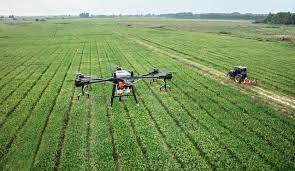
A54- Propose UAS Right-of-Way Rules for Unmanned Aircraft Systems (UAS) Operations and Safety Recommendations
This study seeks to inform rulemaking and standards development regarding potential Right of Way (RoW) concepts for manned and unmanned aircraft in the low altitude environment. The research will help identify gaps in current rules regarding new entrants into the airspace, as well as explore options for future rules.
The demand in the UAS industry is for new operational scenarios, involving beyond visual line of sight (BVLOS) concepts, such as medium- to large-sized UAS, and UAS in formation, i.e., swarms. In these situations, current RoW rules prove to be insufficient, and may need to be modified or extended. There is also ambiguity for mid-sized UAS that may be difficult for other pilots to see. Rules have yet to be developed for interactions between two unmanned aircraft or for UAS swarms. Right-of-way rules impact UAS Detect and Avoid (DAA) requirements and the development of industry standards.
The outcomes of the research effort will include proposed guidance, recommendations, and/or requirements useful for FAA decision-making for challenges such as UAS waiver assessments, policy development, rulemaking, and the development of UAS industry standards on design, training, operations, and procedures.
Highlights
- A comprehensive background report was developed to support the project by organizing the problem space and providing background for RoW rules and concepts for both manned and unmanned aviation.
- Through dialogue with industry and FAA, the project team prioritized the gaps for which subsequent research will be focused on.
- Based on findings of the background report and the continuous dialogue with FAA and industry, a UAS safety hierarchy is being developed.
Principal Investigator: M.Ilhan Akbas, Ph.D.
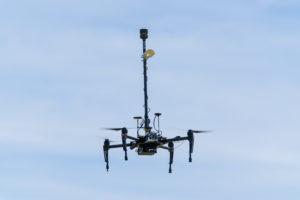
A55 – Identify Flight Recorder Requirements for Unmanned Aircraft Systems (UAS) Integration into the National Airspace System (NAS)
The aviation industry uses flight data recorders (FDR) and cockpit voice recorders (CVR) to investigate accidents and incidents. FDRs record sensor data to provide information about an aircraft’s technical status, while CVRs record sounds from the cockpit to draw conclusions through crew communications and environmental sounds. The American National Standards Institute (ANSI) Unmanned Aircraft Systems Standardization Collaborative (UASSC) standardization roadmap v2.0 indicates that there are significant gaps regarding these flight recorders for UAS. Therefore, the purpose of this project is to close these gaps and define appropriate requirements for FDR and CVR for UAS in the national airspace.
The project is divided into subtasks. The first major step is the literature review of current data recorder standards, technologies, and their requirements for UAS and UAM aircraft. The requirements of various government organizations and institutions are analyzed in this step. The next step is to examine the requirements found. Within this task, it is investigated how applicable the existing requirements are to various categories of UAS. If there are problems adapting these requirements, the corresponding standards will be adjusted. The research will especially focus on test procedures for crash survival, methods for data recording, and the minimum data required.
Highlights
- Review of FDR and CVR requirements from various sources including the Code of Federal Regulations, EUROCAE, and ICAO.
- Analyzing different UAS categories and their corresponding FDR and CVR needs.
Principal Investigator: Richard S. Stansbury, Ph.D.

A57 – Investigate Detect and Avoid (DAA) Track Classification and Filtering
The research team consisting of The Ohio State University (OSU), Embry-Riddle Aeronautical University (ERAU), Mississippi State University (MSU), University of North Dakota (UND), and Cal Analytics will work together to:
- Identify the key sources of misleading surveillance information produced by airborne and ground-based detect and avoid (DAA) systems. Develop risk modeling and analysis tools to assess the system-wide effects of false or misleading information on alerting and separation as well as impacts on pilots in command (PIC) and air traffic operators.
- Provide guidance and recommendations for track classification and filter performance and safety requirements to standards bodies including Radio Technical Commission for Aeronautics (RTCA) and American Society for Testing and Materials (ASTM) DAA working groups and inform Federal Aviation Administration (FAA) rulemaking on DAA operations.
Current guidance provided by the Federal Aviation Administration (FAA) has made beyond visual line of sight (BVLOS) missions an executive priority. Key to the success of these missions is the development of DAA systems capable of providing accurate pilot in the loop, or autonomous deconfliction guidance. Current standards for DAA services provided by RTCA and ASTM do not address the requirements for system performance with respect to generation of false or misleading information to the PIC or autonomous response services of the unmanned aircraft system (UAS). This research will identify key sources of uncertainty in representative DAA architectures and assess the downstream risks and effects of spurious information on downstream system performance. Additionally, recommendations will be developed for track classification accuracy requirements that provide sufficient safety margins for enabling DAA services in support of BVLOS missions.
Principal Investigator: Richard Prazenica, Ph.D.
